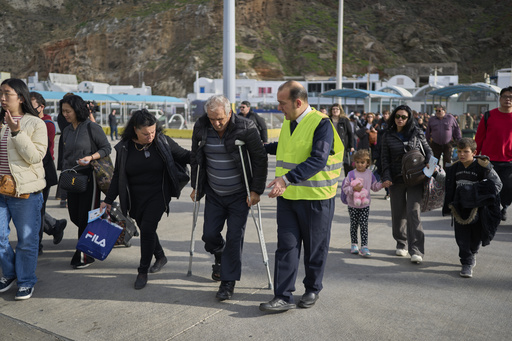
Multiple earthquakes have been shaking the volcanic island of Santorini, Greece, which has prompted local authorities to send out rescue teams equipped with tents, drones, and sniffer dogs, alongside the closure of schools on four islands.
Residents are being urged to refrain from gathering indoors, ensure they know their exit routes, maintain distance from cliff edges, and empty swimming pools to help mitigate potential damage to structures in the event of a significant earthquake.
Greece is located in a seismically active region, where tremors are common. While most earthquakes result in little to no damage or injury, there have been fatal instances in the past. Although predicting earthquakes is impossible, precautionary steps are being implemented by authorities.
Famous for its stunning views, Santorini was shaped by a massive volcanic eruption in ancient times. Each year, millions flock to the island to admire its picturesque white houses and blue-domed churches, which line the cliffs of the caldera.
Recently, scientists have reported an increase in volcanic activity within the caldera of Santorini, though they claim this is not connected to the ongoing earthquakes.
As of the latest updates, around 200 quakes registering between magnitudes of 3 and 4.9 occurred from Saturday through Monday afternoon, primarily affecting the area between Santorini and the nearby island of Amorgos. Seismologist Gerasimos Papadopoulos noted that while seismic activity began on January 24, it escalated significantly on Saturday, with a higher frequency and intensity of quakes.
The fault line responsible for this wave of earthquakes stretches for approximately 120 kilometers (75 miles), yet only the southern segment between Santorini and Amorgos is currently activated.
Most of the tremors have their epicenters beneath the sea, around 30-40 kilometers (18-25 miles) away from the islands, which scientists believe is a positive factor, as earthquakes with land-based epicenters can be more damaging. Nonetheless, there remains a risk that a large quake could prompt a tsunami, leading authorities to advise residents to avoid coastal regions and move inland if they experience significant shaking.
As of now, reports have indicated no severe damage or injuries; however, minor rock slides have been observed.
Santorini is part of the Hellenic Volcanic Arc, which extends from southern Greece to the Cycladic islands, and monitoring activities have revealed low levels of seismic-volcanic activity in the area. Although similar activity was recorded in 2011 without major consequences, the submarine volcano Kolumbo, located 8 kilometers (5 miles) northeast of Santorini, is also monitored closely.
Officials are concerned about the current quakes potentially serving as foreshocks, which are smaller tremors occurring before a larger earthquake. According to Papadopoulos, there is a “high probability” that this is the case.
The main villages of Santorini are positioned along the edge of the caldera, creating breathtaking landscapes but also heightening vulnerability in the event of a significant quake, particularly due to the steep cliffs that increase the risk of landslides.
In response, rescue personnel equipped with drones and sniffer dogs have been dispatched to Santorini, where they have set up tents alongside the primary hospital as a base of operations. Alerts have been issued to cellphones advising residents to stay away from areas prone to rock slides and restricting access to certain coastal locations.
Moreover, both residents and hotels have been instructed to drain swimming pools, as water movement during a strong quake can destabilize buildings. Instructions to avoid old structures and identify escape routes have also been disseminated.
Schools on Santorini and in nearby islands including Anafi, Amorgos, and Ios will remain closed for the week.
Historically, the fault line currently under stress was the site of Greece’s most powerful earthquake in the last century—a 7.7 magnitude tremor in 1956, which resulted in a devastating tsunami and significant damage, particularly in Amorgos and Santorini, claiming over 50 lives.
Moreover, Santorini is infamous for the Minoan eruption around 1,600 B.C., one of the largest volcanic eruptions recorded in history, which fundamentally transformed the island’s shape and contributed to the decline of the Minoan civilization.
Despite being an active volcano, its last major eruption was in 1950. According to Efthymios Lekkas, the head of Greece’s scientific monitoring committee for the Hellenic Volcanic Arc, significant eruptions from the Santorini volcano occur every 20,000 years. With the last explosion being 3,000 years ago, he emphasizes that a major eruption is not imminent.

